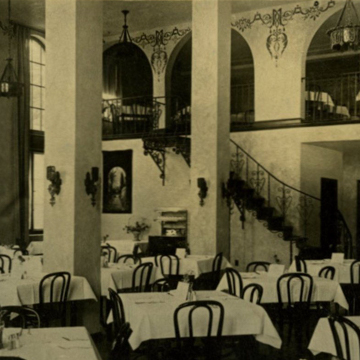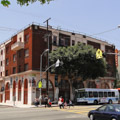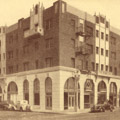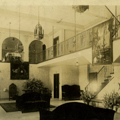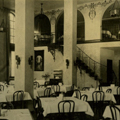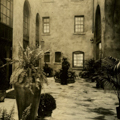Dunbar Hotel
The Hotel Somerville opened to great fanfare in June 1928. Drs. John and Vada Somerville built this grand hotel on Central Avenue, a Los Angeles business district that began to emerge south of downtown in the early 1900s and over the next fifty years became home to dozens of Black-owned businesses including filling stations, sweet shops, beauty parlors, cigar stores, cleaners, and cafes. The hotel itself was built entirely by Black contractors, laborers, and craftsmen, and was also owned and financed by members of the Black community. Central Avenue was the social and economic artery within a restricted area in which African Americans were permitted to live. The avenue ran north-south and was serviced by streetcars, which facilitated the easy movement of patrons up and down the avenue. Central Avenue is today best known for its role in the development of west coast jazz, and several nightclubs and a suite of jazz clubs helped establish the street as a legendary music strip.
The Somerville’s siting at 41st Street and Central was slightly off main activity, which at that time was closer to 12th Street, but the hotel’s opening spurred an increase in building that drew businesses further down the avenue. The hotel was not the Somervilles’ first foray into real estate. In 1927, they built the La Vada, touted as the first modern apartment building for African Americans. According to his autobiography, John Somerville took out a $100,000 loan to build a new hotel, and formed an investment company that included Charlotta A. Bass, the formidable publisher-editor of the California Eagle (est. 1879), considered the oldest African American newspaper in the west. The four-story hotel contained guest rooms on the top three floors, with the ground floor set aside for the lobby and commercial and professional offices, which over the years housed several entities, including beauty shops, cafes, restaurants, and a cocktail lounge.
Like many hotels of the era, the Somerville originally had two entrances, one on 41st Street and one facing Central Avenue. The exterior combined locally popular Art Deco and Mediterranean ornamental features, primarily in brown brick, carved stone, and stucco. The ground floor was articulated through a series of arched bays with semicircular windows; the brown brick facade was punctuated by carved stone balconies mounted above the entrances and on two rooms on the top floor. Carved keystones, Churrigueresque carving, and Spanish Revival ornamentation were also to be seen on the parapets, now removed.
The 41st Street entrance featured an interior patio set with local stone, and tiled mosaics that opened to a grand lobby lit with dropped perforated-metal chandeliers. A mezzanine level for orchestras carried the arches and stuccoed surfaces into the interior and included murals within blind arches that depicted three scenes of California landscapes—the desert, mountains, and a mission scene. The hotel opened with 115 rooms (75 had en suite baths) and was considered an immediate success, helped in part by the presence of the West Coast NAACP meeting that same year, which assured that many dignitaries would be introduced to the hotel. Despite its initial success, the Somervilles soon encountered financial and legal problems. In March 1929, the Lincoln Hotel Company of America purchased the building, and though there was further court action, in the end, the litigation and the crash of 1929 likely combined to separate the Somervilles from the hotel. It was purchased by Lucius Lomax, who is credited with changing the hotel’s name to the Dunbar, in honor of the poet and writer Paul Dunbar.
In the 1930s, the Dunbar Hotel housed many performers that were prohibited from staying in white hotels, including Duke Ellington, Billie Holiday, Count Basie, Lionel Hampton, Ella Fitzgerald, and Lena Horne. Actors haunted the lobby, which was an informal casting office for Black extras during this period. An elite destination, room prices were higher at the Dunbar than other African American hotels, but it remained firmly rooted in the nightlife culture of Central Avenue.
In 1936, Chicago businessman James “Jimmy” Nelson purchased the building from the Mortgage Guarantee Company. The Dunbar Hotel continued to attract travelers over the next 30 years and was listed annually in every major guide for Black travelers, including the Green Book and Travelguide, through the early 1960s. As the automobile supplanted the streetcar, and housing restrictions on African Americans eased slightly in the 1950s, businesses and clientele begin to move out of the densely settled districts near Central Avenue. By 1965 most of the professional offices, theaters, and businesses were gone. In 1965, the Watts Riots spread to Central Avenue, further destroying the prospects of the businesses that remained. Bernard Johnson purchased the hotel in 1968 but closed it in 1974; he then established the Dunbar Hotel Cultural and Historical Museum. In 1990 the vacant hotel was renovated to become affordable senior housing, and in 2014 it underwent a $14 million renovation. Now part of Dunbar Village, the affordable housing project offers 41 apartments.
References
Daniels, Douglas Henry. “Los Angeles's Jazz Roots: The Willis H. Young Family.” California History 82, no. 3 (2004): 48-70.
Johnson, Bernard, “Hotel Somerville/Dunbar Hotel,” Los Angeles County, California. National Register of Historic Places Inventory–Nomination Form, 1976. National Park Service, U.S. Department of the Interior, Washington, D.C.
Marmorstein, Gary. “Central Avenue Jazz.” Southern California Quarterly 70, no. 4 (Winter 1988): 425-426.
Sweeting, Anthony Charles. “The Dunbar Hotel and Central Avenue Renaissance, 1781-1950.” Ph.D. diss., University of California, Los Angeles, 1992.
Writing Credits
If SAH Archipedia has been useful to you, please consider supporting it.
SAH Archipedia tells the story of the United States through its buildings, landscapes, and cities. This freely available resource empowers the public with authoritative knowledge that deepens their understanding and appreciation of the built environment. But the Society of Architectural Historians, which created SAH Archipedia with University of Virginia Press, needs your support to maintain the high-caliber research, writing, photography, cartography, editing, design, and programming that make SAH Archipedia a trusted online resource available to all who value the history of place, heritage tourism, and learning.




